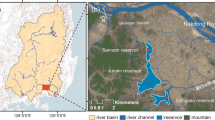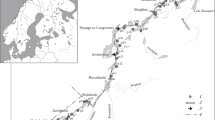Conclusions
Macrophytes in the case of their controlled development are an effective means of improving water quality.
The participation of hydrobiologists and geobotanists both in the design and construction of reservoirs will help to establish the effectiveness of self-purification being accomplished by components of the biota and especially by macrophytes.
When designing reservoirs and their engineering it is necessary to take into account natural conservation measures aimed at improving water quality, including a bank water-protection zone, beaches, bioplateaus with macrophytes, means for harvesting the plant biomass, and conditions of its transporting, processing, and utilization in the economy.
Similar content being viewed by others
Literature cited
World Reservoirs [in Russian], Nauka, Moscow (1979).
A. B. Avakyan and V. A. Sharapov, Reservoirs of USSR Hydroelectric Stations [in Russian], Energiya, Moscow (1977).
A. V. Frantsev, “Ways to improve the water quality of reservoirs and canals,” Gidrotekh. Melior., No. 2 (1982).
A. V. Frantsev, “Some problems of water-quality management,” in: Theory and Practice of Biological Self-Purification of Polluted Waters [in Russian], Nauka, Moscow (1972).
A. I. Zhukov, I. L. Mongait, and I. D. Rodziller, Industrial Waste-Water Treatment Methods (Manual) [in Russian], Stroiizdat, Moscow (1977).
I. L. Korelyakova, Vegetation of the Kremenchug Reservoir [in Russian], Naukova Dumka, Kiev (1977).
A. V. Topachevskii, Ya. Ya. Tseev, and L. A. Sirenko, Technical and Biological Conditions of the Design, Reconstruction, and Operating Regime of Hydrostation Reservoirs [in Russian], Naukova Dumka, Kiev (1974).
A. R. Orekhovskii, “Protective effect of emergent plants,” Gidrotekh. Melior., No. 7, (1982).
P. G. Krotkevich, “Use of the water-protecting and purifying properties of the common reed,” Vodn. Resur., No. 5 (1976).
S. Björk and W. Cranelli, “Energy, reed and environment,” Ambio,7, No. 4 (1978).
A. A. Potapov, “Anophelogenic significance of wild rice plantings on reservoirs,” Med, Parazitol. Parazit. Bolezni, No. 3 (1957).
K. Seidel and H. Happel, “Gewasserverschlammung. Hohere Pflanzen als Verursacher und Helfer,” Umscnau, Bd. 83, No. 25–26 (1984).
Additional information
Translated from Gidrotekhnicheskoe Stroitel'stvo, No. 9, pp. 57–61, September, 1984.
Rights and permissions
About this article
Cite this article
Avakyan, A.B., Éinor, L.O. Role of higher aquatic vegetation in improving water quality and increasing biological productivity of reservoirs. Hydrotechnical Construction 18, 454–459 (1984). https://doi.org/10.1007/BF01433671
Issue Date:
DOI: https://doi.org/10.1007/BF01433671




